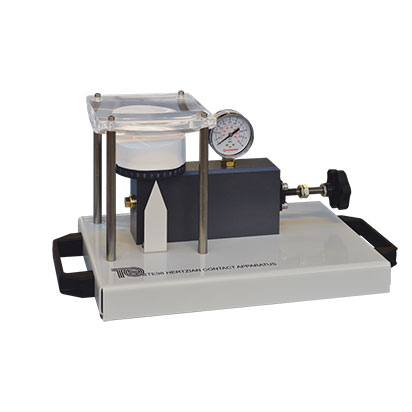Description
A self-contained unit for practical examination of Hertz’ theories of contact between materials. It demonstrates on a large scale the nature of contact between non-conforming bodies. For example: between the ball and race in a bearing.
The Hertzian Contact Apparatus is a self-contained and easy-to-use unit that shows the nature of contact between two surfaces. It compares experiment results with predictions based on Hertz’s original theories. This helps engineers to predict contact areas between common machined surfaces and materials, for example different types of bearings.
The apparatus has two pads with curved contact surfaces. The upper pad (made of a transparent plastic material) has a compound radii. The lower pad (made of an opaque flexible material) has a simple radius. A hand-operated hydraulic pump and cylinder force the two pads together. Students may rotate the lower pad, a pointer shows the angle of rotation. This allows a study of the effect of different relative curvatures.
A contact shape (or ‘zone’) forms between the pads. The contact zone may be circular or elliptical, depending on the relative angular position of the two pads. Supplied is a transparent scale to measure the contact shape and angle. Locknuts on the threads of the pump work to limit the maximum pressure, preventing damage to the equipment.
Key features:
- Helps engineers to study and predict contact shapes between common machined surfaces and materials
- Compact, self-contained unit – needs no electricity or external services
- Uses flexible material to produce magnified and easily viewed results
- Controllable hydraulic pressure system with gauge for repeatable results
- Simple design for ease of use
- Variable relative contact angles and pressures for a range of experiments
Learning outcomes:
- The effect of varied pressure with constant angle.
- The effect of varied angle (different relative curvature) with constant pressure.





